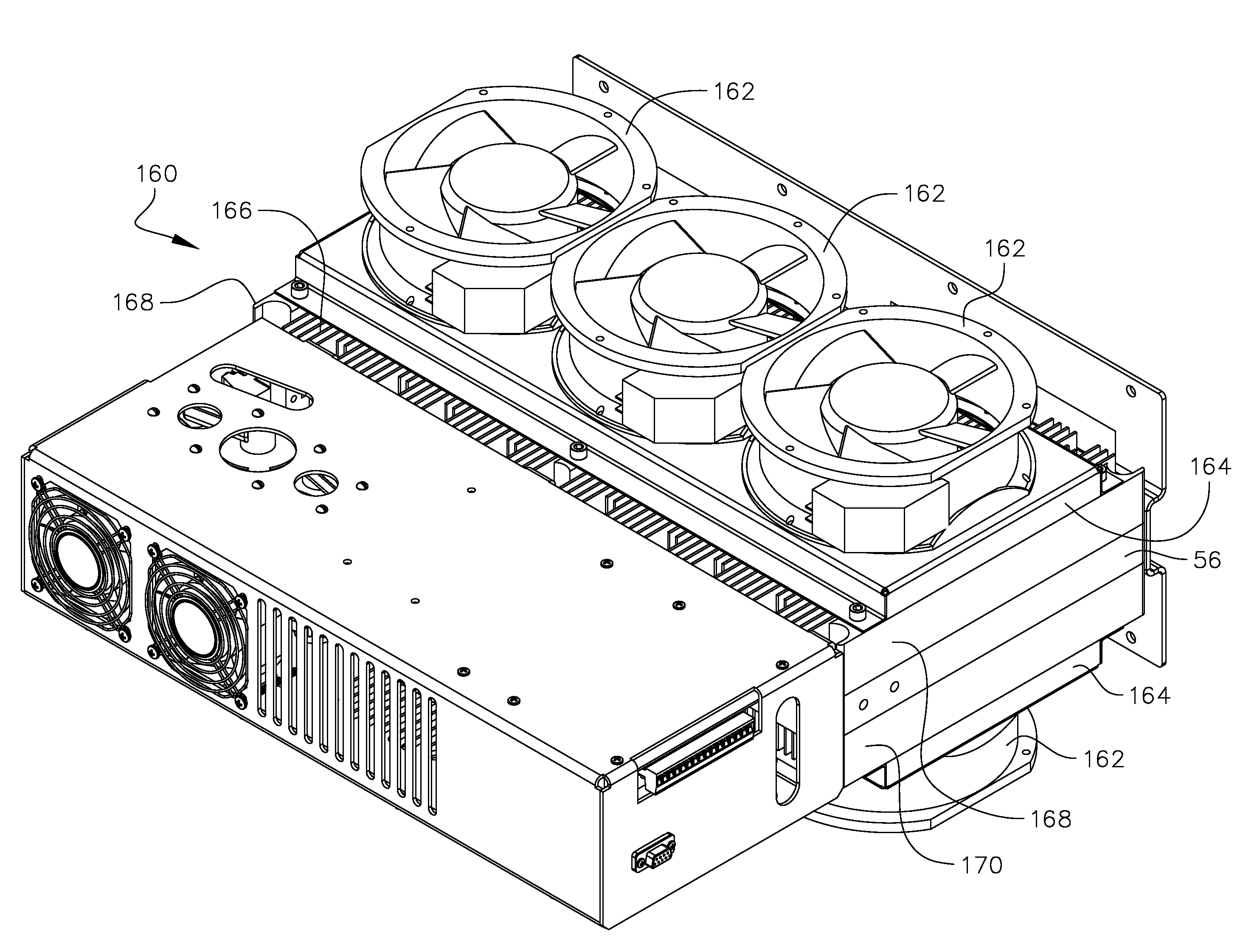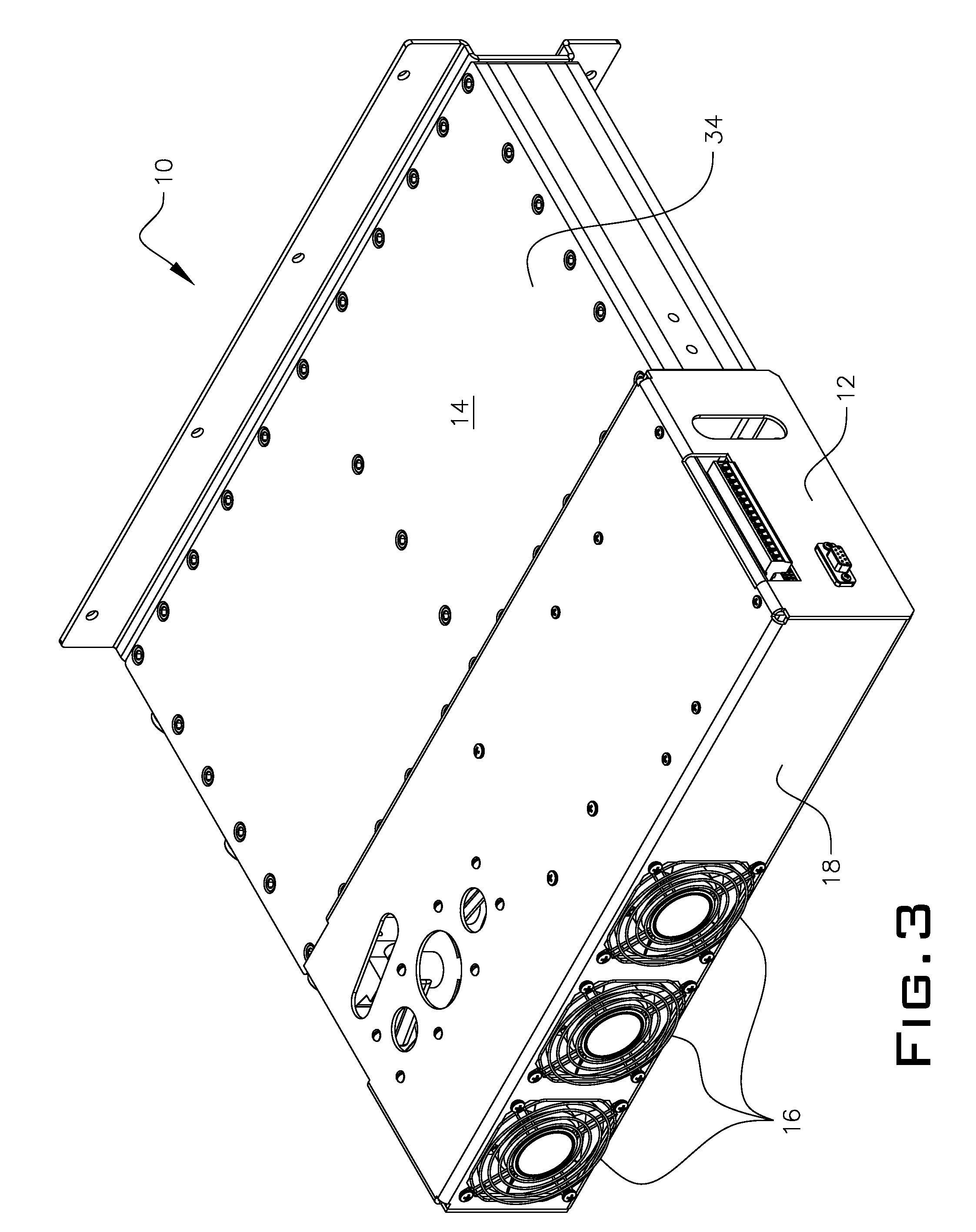[0018]The upper housing encloses all of the
electronics that power and drive the module while the lower housing contains the ozone generating cells, an internal liquid coolant system, a spring plate forced distribution and
equalization system, Teflon locators or locators of equally durable material, working in
coincidence with the forced distribution and
equalization system, an orifice system for maintaining a known and controllable pressure drop across the generation cells, a center body framing element for locating and separating the four ozone generating cells into two pair, as well as liquid coolant inlet and outlet ports, an
oxygen inlet port and an ozone outlet port. On either side of the negative electrodes is the internal coolant system formed from a machined plate structure, which forms one of a multitude of section
layers making up the lower housing. Each coolant system contains an inlet portion that connects to a liquid manifold (in the preferred embodiment) that is in communication with the inlet port of the center body framing element. The liquid coolant system has a plurality of fins formed therein for moving liquid over the
plasma generator (one each on each side of each sub-cell of any one generating cell of the four contained within a module) for removing heat during ozone production therein and for moving
excess heat out of the modular ozone generating system. This unique internal cooling system allows the ozone to be cooled as it leaves any given module. Further, the fact that the micro-channel networks for the ozone production is positioned on the opposite side of the
ceramic plates helps to keep the system completely dry. This permits the compact size as seen in the present invention, all the while producing a very large capacity output of ozone that could never be accomplished in the prior art as previously discussed in the background of the Invention.
[0019]Each module can slide into a single slot of a tray, wherein each slot has a pair of locating pins and an
electrical connection block located at a top portion thereof. The module locating pins and the
electrical connection block are formed as one floating piece that permit a slight amount of movement or “play” for module alignment purposes. Aligned in a vertical position along the back side of each slot is a rail connection bar in the tray. There are module inlet and outlet port connectors that also float and permit a slight amount of movement for module alignment purposes within each slot. Further, vertically disposed protuberances can be employed between any of the module inlet and outlet ports to provide horizontal (i.e., side to side) stabilization of the module when inserted into a respective tray slot. Two protuberances are used on the preferred embodiment, however less than or more than two can be employed as needed. All of the floating and locating parts discussed hereinabove work in
coincidence to provide stabilization to the module when inserted in the tray and in particular assist in reducing loads at any given connection point or part so that no particular connector bears a greater amount of weight than is necessary or that would cause it to degrade more rapidly. For avoidance doubt, the unique stabilization system of the present invention spreads out the load of the module about all connectors and connection fittings. As an added benefit, this ensures no leakage at any of the ports that pass the liquid,
oxygen and ozone in and out of the module and through the tray or other manifold that may be used herein.
[0024]Further, the modular ozone generator of the present invention operates at high frequencies outside the hearing of the
human ear (i.e., 25 kHz). This is another vast improvement over the prior, which run at frequencies that are damaging to the
human ear (within the range of the
human ear, 20-20 k Hz) when in close proximity for long periods of time. Still further, the modular
ozone generators of the present invention are all powered equally, one module by itself or in a rack, such that the same pulses are all fired at the same time to avoid a problem in the prior art known as cross-firing.
[0025]Other important aspects of the present invention that should be noted are that each modular unit by themselves, or in a rack, includes self pressure compensation and each modular unit has a fixed orifice to produce
back pressure to balance all of the cells to the same output. Further,
internal temperature protection shuts down power (power
cut-back) to prevent overheating. This is designed into the ozone generating
cell control software. Analog controls are provided for safety and on-off functions. Further, algorithms for auto control during
start up and shutdown are employed. The system is designed to react to the liquid
chemistry and is equipped with an in-house designed oxygen destruct system. Over-
voltage protection is designed into the modular units and into any racks housing more than one unit.
[0027]Finally, it should be noted that the modular ozone generator of the present invention or any rack or
assembly formed by a plurality of modular units has increased economical advantages and efficiencies that allow the present invention to be labeled as “Green.” These include the instant on-off that saves warm up time and operating costs, the
solid state design that reduces
power consumption, the
power demand that is reduced because of the cooling system that saves a maximum amount of ozone by immediately cooling the ozone upon creation thereof, the power that is conserved by the use of minimal DC pulses for continuing an efficient ozone plasma, the liquid use that is low because it is optimized via
computer analysis, the fact that the system maximizes the amount of ozone that gets out of the unit by immediately cooling the ozone, the further fact that the system has instant control for instant reaction to liquid
chemistry, which saves on over production of ozone and subsequent destruction, that the system reacts to vary the power in relation to the requirement for ozone, that the system is designed to provide input to the oxygen separator so that it works in
unison and reduces compressor loads and therefore subsequent power is reduced, that a minimal foot print reduces building costs as well as up-keep and maintenance costs and finally, but not limited to, that the
software is designed to “soft start to last run settings” while
instrumentation comes on line and levels out.
 Login to View More
Login to View More  Login to View More
Login to View More 


